Eremurus: Care Guide for Flower
Eremurus, commonly known as Foxtail Lilies, are a striking addition to any garden landscape. These plants are renowned for their tall, spiky flower stalks that can reach impressive heights, often towering above other plants in the garden. Their unique blooms, arranged in dense clusters along the stem, create a vertical explosion of color that makes them stand out in any setting.
Eremurus flowers are available in a wide range of colors, from creamy whites to vibrant yellows, oranges, and pinks, often with a slight frosty or iridescent sheen. These flowers bloom in late spring to early summer, providing a beautiful contrast to other seasonal blooms.
A great feature of Eremurus is its versatility in the garden. They thrive in well-drained, sunny locations and are perfect for adding height and structure to perennial borders, rock gardens, or wildflower meadows. Additionally, they attract pollinators, such as bees and butterflies, making them a valuable addition to any wildlife-friendly garden. Our gardening blog is a perfect place to find all the information you need!
Why Choose Eremurus for Your Garden or Home?
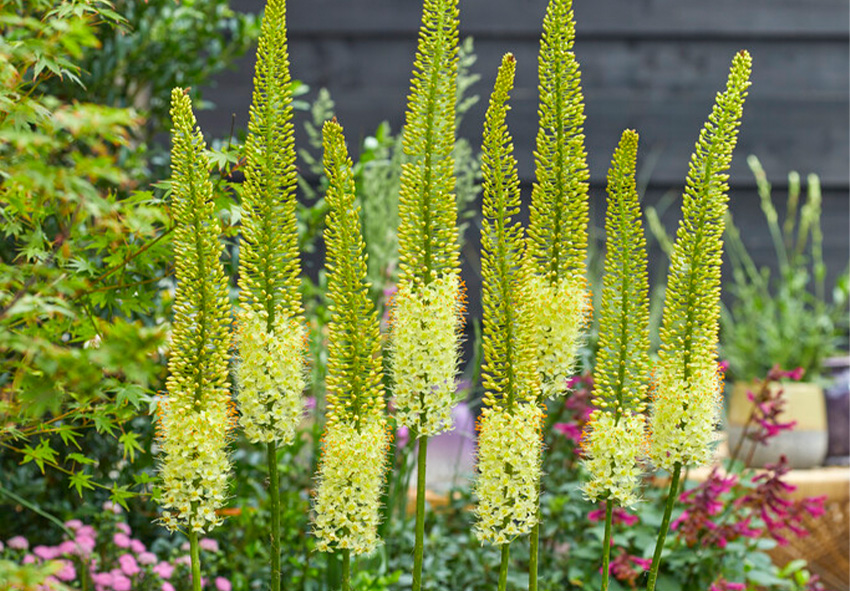
Eremurus, or Foxtail Lilies, are a fantastic addition to any garden due to their bold, vertical growth and striking appearance. Known for their tall, spiky flower stalks that can reach up to 6 feet, they create a dramatic effect in the garden. Their flowers are arranged in dense clusters, providing an explosion of color that draws the eye upward and adds dimension to landscapes.
In addition to their aesthetic appeal, Eremurus are also drought-tolerant once established. They can thrive in less-than-ideal soil conditions, making them perfect for dry, rocky areas or those with poor water retention. This resilience makes them a low-maintenance option for gardeners looking for beautiful, hardy plants that require minimal care.
Eremurus are also a valuable asset for attracting pollinators. Their large, tubular flowers are a favorite of bees, butterflies, and hummingbirds, helping to support biodiversity in the garden.
Whether planted in perennial borders, rock gardens, or even container gardens, Eremurus adds height, structure, and a touch of elegance. Their ability to thrive in full sun and attract pollinators makes them an excellent choice for those looking to enhance both the visual appeal and ecological health of their garden or home.
The Most Popular Eremurus Varieties and Their Characteristics
Eremurus offers a variety of species and cultivars, each with unique characteristics and appeal. Here are some of the most popular varieties that can elevate your garden:
- Eremurus stenophyllus (Narrow-Leaf Foxtail Lily) – Known for its slender leaves and elegant, creamy white to pale yellow flowers, this variety adds a soft touch to garden landscapes. It’s perfect for rock gardens or borders where space is limited but height is desired.
- Eremurus robustus – One of the larger varieties, Eremurus robustus boasts dramatic flower spikes that can reach up to 6 feet tall. It produces striking yellow to orange blooms, making it an excellent choice for creating bold focal points in the garden.
- Eremurus himalaicus (Himalayan Foxtail Lily) – With its dense, peach-colored flowers, Eremurus himalaicus stands out for its vibrant and warm hues. This variety thrives in well-drained soil and is perfect for adding a pop of color to perennial borders.
- Eremurus ‘Cleopatra’ – A hybrid variety, ‘Cleopatra’ has soft peachy-pink flowers with a gentle fragrance. It’s a great option for adding an elegant and slightly more subdued hue to garden landscapes.
These varieties are perfect for attracting pollinators and adding structure and beauty to any garden. Whether you are looking for height, color, or pollinator-friendly options, there is an Eremurus variety that will fit perfectly into your landscape design.
Classic Yellow and Orange Eremurus Varieties
Eremurus varieties with yellow and orange flowers bring bold, vibrant color to any garden. These varieties are ideal for adding a warm, sunny touch to your landscape. Some of the most popular yellow and orange Eremurus varieties include:
- Eremurus Yellow – Known for its tall, robust flower spikes, this variety features stunning yellow flowers that create a dramatic focal point in the garden. It can reach heights of 6 feet and thrives in full sun with well-drained soil.
- Eremurus ‘Cleopatra’ – A hybrid variety with warm orange and yellow flowers, ‘Cleopatra’ is perfect for adding a burst of color. Its elegant, arching flower spikes make it an excellent choice for borders, containers, or cutting gardens.
These varieties are excellent for creating a lively, eye-catching atmosphere in your garden, especially in sunny spots where their vibrant colors can truly stand out.
White and Cream Eremurus for Elegant Gardens
For those looking for a more refined, elegant touch in their garden, white and cream-colored Eremurus varieties offer a soft, sophisticated look. These varieties are perfect for creating serene, understated beauty. Some popular options include:
- Eremurus himalaicus – This variety is known for its graceful, creamy-white flowers that bloom in dense clusters. Eremurus himalaicus is ideal for creating a serene, elegant atmosphere, especially when paired with other pastel-toned flowers in the garden.
- Eremurus ‘White Beauty’ – As the name suggests, ‘White Beauty’ is a pristine white-flowered variety with striking, vertical spikes that create a stunning contrast against other colorful blooms. It thrives in well-drained soil and is a great addition to perennial borders or mixed beds.
These white and cream varieties add a touch of sophistication and elegance, perfect for creating refined, harmonious gardens that draw attention without overwhelming the senses.
Pink and Peach-Toned Eremurus for Soft Accents
Pink and peach-colored Eremurus varieties bring a soft, romantic touch to any garden. These delicate hues are perfect for adding gentle accents that complement other flowers. Some standout varieties include:
- Eremurus Romance – This variety features soft pink flowers with a subtle fragrance, making it a lovely addition to any garden. ‘Romance’ blooms in late spring to early summer, offering a burst of color without being overpowering.
- Eremurus ‘Rosalie’ – With its peachy-pink flowers, ‘Rosalie’ provides a warm, elegant contrast to other blooms. This variety adds a gentle touch of color, making it ideal for creating a soft, romantic garden atmosphere.
These pink and peach-toned Eremurus varieties are perfect for creating softer accents in your garden or flower arrangements, adding charm and beauty to any landscape.
Rare and Exotic Eremurus Hybrids
For gardeners seeking unique and extraordinary blooms, rare and exotic Eremurus hybrids offer distinct characteristics and striking beauty. These hybrids combine the best qualities of their parent species to produce exceptional flowers. Some noteworthy hybrids include:
- Eremurus Ruiter Collection – Known for their impressive size and robust growth, this hybrids feature stunning color combinations and large, dense flower spikes. These hybrids are perfect for creating dramatic vertical interest in garden designs.
- Eremurus Bungei – This hybrid is prized for its unusual, exotic appearance. It produces tall, vibrant flower spikes with shades of orange, red, and yellow, making it a striking addition to any landscape. Eremurus Bungei thrives in sunny locations with well-drained soil.
These rare and exotic hybrids provide an extraordinary look for gardeners who want to add something different and impressive to their collection. Their vibrant, one-of-a-kind blooms are sure to make a statement in any garden.
How to Plant and Grow Eremurus Successfully
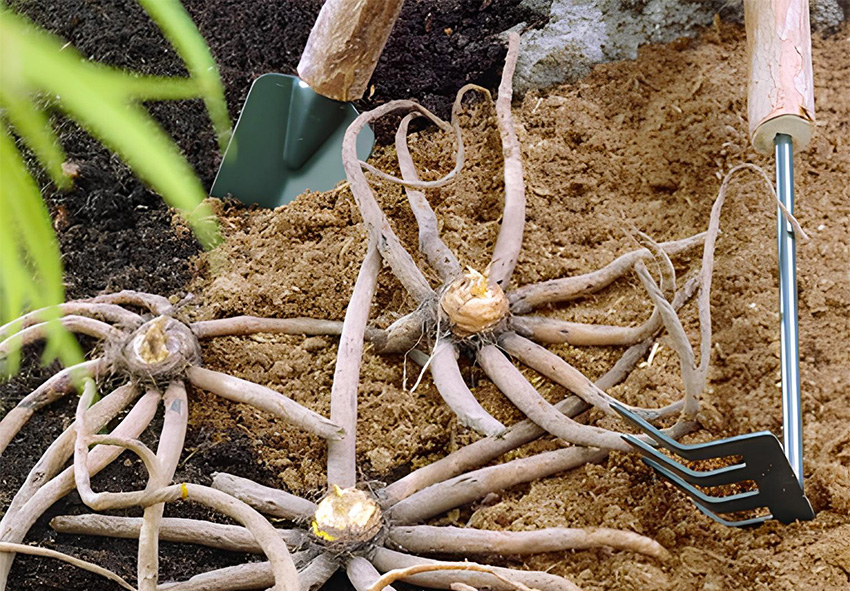
Planting and growing Eremurus, or Foxtail Lilies, requires some specific care to ensure that they thrive in your garden. These striking plants produce tall, spiky flower spikes in late spring and summer, adding vertical interest to any landscape. To achieve healthy growth and beautiful blooms, it is crucial to plant Eremurus correctly and provide the right care.
Eremurus bulbs (also known as tubers) are sensitive to both overwatering and underwatering, and they need the right environment to grow successfully. They require well-draining soil, full sunlight, and protection from strong winds. When planted in the proper conditions, they will develop long-lasting root systems, producing their distinctive flower spikes in time.
By following a step-by-step guide to planting, watering, and maintaining Eremurus, you can enjoy their showy, tall blooms year after year. Pay close attention to planting depth, spacing, and soil conditions, and remember to protect your plants from frost in early spring. These plants are best suited to garden beds with plenty of sunlight and air circulation. Now let’s dive into the essential steps for planting and caring for Eremurus.
Step-by-Step Guide to Planting Eremurus
Planting Eremurus bulbs requires attention to soil, depth, and spacing to ensure healthy growth. Follow the steps below for successful planting, watering, and maintaining these beautiful plants. Proper eremurus bulb care will lead to tall, elegant flower spikes that enhance any garden with their striking visual appeal.
Step 1: Choosing Healthy Eremurus Roots (Tubers)
When selecting Eremurus tubers, it’s essential to choose large, healthy ones to give your plants the best start. Look for tubers that are firm, plump, and have well-formed roots. The tuber should be free from signs of rot or damage. Avoid those that are dry, brittle, or show visible signs of decay. Healthy tubers have a slight sheen and should feel dense to the touch.
If you’re purchasing Eremurus tubers from a nursery or online, inspect them closely for signs of mold or damage. Healthy roots should be white or light-colored, and they should not have any soft spots, which are indicative of rot. You want to ensure that each tuber has a good number of roots, as these will anchor the plant into the soil and provide the necessary nutrients for growth.
By choosing the best tubers, you’ll ensure that your Eremurus plants have the best chance of growing into strong, vibrant flowers. Healthy tubers lead to faster establishment, stronger growth, and more blooms throughout the growing season.
Step 2: Choosing the Right Soil and Location
Eremurus thrives in well-draining soil that provides the right balance of nutrients while preventing waterlogged conditions, which can lead to rot. Ideal soil types for Eremurus are sandy or loamy, with a pH level ranging from 6.5 to 7.5. Well-draining soil ensures that water flows freely through the roots without remaining stagnant, which is essential for the health of the tubers.
When selecting a location for planting, choose a spot that receives full sun for at least 6 hours per day. Eremurus needs ample sunlight to grow strong and produce vibrant flower spikes. Additionally, ensure the location is sheltered from strong winds, as the tall flower stalks can be prone to breakage. A sheltered location also protects the delicate young shoots in early spring.
Before planting, enrich the soil with compost or organic matter to improve drainage and soil fertility. Ensuring the right soil type and location will give your Eremurus plants the best chance of growing strong, healthy flowers.
Step 3: Proper Planting Depth and Spacing
When planting Eremurus tubers, it is important to plant them at the right depth to allow for proper root establishment and growth. Ideally, tubers should be planted 2-4 inches deep, with the pointed end facing upwards. Spread the roots out carefully to avoid damaging them, ensuring they have enough space to grow freely. This depth allows the tuber to stay stable while allowing the growing plant to reach the surface easily.
Proper spacing is equally important to ensure the plants have enough room to expand and thrive. Space each tuber 12-18 inches apart. This gives the plants ample room to grow their large, upright flower spikes without overcrowding. Overcrowding can lead to poor air circulation, which can promote fungal diseases or weak growth.
By following these guidelines for depth and spacing, you help ensure that your Eremurus plants will have the space and support they need to grow tall, healthy, and produce beautiful flowers.
Step 4: Watering After Planting
After planting your Eremurus tubers, it’s essential to water them thoroughly to encourage root establishment. Initially, water the soil deeply to help the tuber settle in and begin the growing process. Ensure that the soil remains moist but not overly saturated. Eremurus prefers well-draining soil, and excess water can lead to rot, which is a common issue for these plants.
Once the tubers have been watered in, allow the soil to dry between waterings. Overwatering can be just as harmful as underwatering, as it can promote fungal growth and waterlogging. During the early stages of growth, water once or twice a week, depending on the weather. If the weather is hot and dry, you may need to water more frequently, but always ensure the soil drains well after watering.
As the plants establish themselves and begin to grow, reduce watering and allow the soil to dry more thoroughly between watering sessions. This will help mimic the conditions that Eremurus naturally thrives in.
Step 5: Providing the Right Growing Conditions
After planting, it’s crucial to provide the right growing conditions for Eremurus to thrive. One of the most important factors is protecting the young shoots from late spring frosts, as these plants are sensitive to cold snaps. You can use garden fabric or cloches to shield new growth during unexpected frosts.
Additionally, Eremurus benefits from mulching, especially during the summer months. A layer of mulch helps to retain moisture in the soil and regulate the soil temperature, preventing it from becoming too hot or too cold. Mulch also helps suppress weeds, reducing competition for nutrients and water.
Eremurus plants are drought-tolerant once established, but during the growing season, they still need regular water, especially in dry periods. Keep the area free of excessive weeds and debris, which can block airflow around the plants. Proper care in the early stages of growth will result in strong plants and beautiful flowers that bloom throughout the season.
Essential Eremurus Care Tips for Healthy Growth
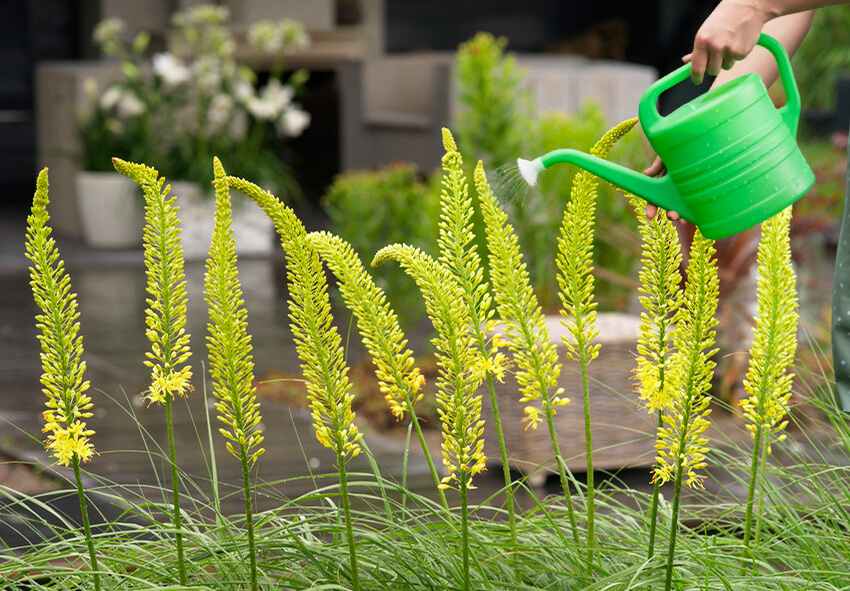
Eremurus, or Foxtail Lilies, are stunning plants that thrive with proper care and attention to their environmental needs. To ensure healthy growth and beautiful flowers, you must provide the right conditions in terms of light, water, temperature, and feeding. These tall, spiky plants need full sun to produce their signature vertical flower spikes, so make sure they receive at least 6-8 hours of sunlight daily.
Watering is crucial, as Eremurus prefers well-drained soil. Water deeply once a week during dry spells, but avoid overwatering, as the tubers can rot in soggy soil. After flowering, reduce watering as the foliage naturally dies back.
In terms of feeding, apply a low-nitrogen fertilizer (5-10-10) in early spring to support strong growth. However, stop fertilizing once the flowers begin to fade, as additional nutrients are no longer needed.
Eremurus also requires some protection from strong winds. Their tall flower spikes can be easily bent or broken by gusts, so using stakes or plant supports will help keep them upright. By following these care tips, you can enjoy healthy, vibrant Eremurus plants that add beauty and structure to your garden.
How to Care for Eremurus After Planting
It’s important to know how to care for eremurus in the garden just as to learn how to care for eremurus indoors. Caring for Eremurus after planting involves proper watering, feeding, and ensuring the right environment. Make sure they get enough sunlight, water appropriately, and protect them from harsh winds. Providing the correct care throughout the growing season will promote healthy plants and impressive flower spikes.
Step 1: Watering Eremurus the Right Way
Watering Eremurus correctly is essential for healthy growth. Initially, water deeply once a week, especially in dry conditions, to ensure the tubers are well-hydrated and can establish a strong root system. Eremurus prefers well-drained soil, so be cautious not to overwater, as excessive moisture can cause the tubers to rot.
As the plants grow, the amount of water they need will decrease. Once the flower spikes have faded and the leaves begin to yellow, reduce watering. This signals the plant’s transition into dormancy. Overwatering at this stage can hinder the plant’s ability to rest and prepare for the next growing season.
During dry spells, especially in the summer, check the soil moisture regularly. If the weather is particularly hot, consider watering a little more frequently, but always make sure the soil dries out between watering sessions to avoid root rot. Watering properly helps keep the Eremurus tubers healthy and ready to bloom the following season.
Step 2: Fertilizing for Strong Growth
Fertilizing is an important aspect of caring for Eremurus to ensure strong growth and vibrant blooms. At the beginning of the growing season, apply a low-nitrogen fertilizer, such as a 5-10-10 blend, to encourage balanced growth. Nitrogen promotes foliage, but too much can result in excessive leaf growth at the expense of flowers. The balanced fertilizer will help to stimulate root and flower development without encouraging excessive foliage.
Fertilize Eremurus in early spring, just as new growth begins. This provides the necessary nutrients to support the plants throughout the growing season. Be sure to follow the fertilizer’s instructions for application rates to avoid overfeeding.
Once the flowers start to fade, it’s time to stop fertilizing. Eremurus doesn’t need additional nutrients at this stage, as they focus on resting and storing energy for the next growing season. By fertilizing appropriately, you can ensure healthy, strong plants that will return year after year.
Step 3: Providing Proper Light and Temperature
Eremurus thrives in full sun and requires at least 6-8 hours of sunlight each day to produce its tall, spiky flowers. Sunlight is critical for the plant’s health and ensures the flowers bloom to their full potential. A sunny location promotes strong, upright growth, and the vibrant colors of the flowers will be more intense under optimal light conditions.
While Eremurus enjoys sunlight, it’s also essential to protect it from harsh winds. The tall flower spikes are susceptible to bending or breaking in strong gusts, which can detract from the plant’s overall appearance. Planting Eremurus in a sheltered spot or using plant supports can help mitigate this risk.
As for temperature, Eremurus is best suited to regions with moderate temperatures, ranging from 15°C to 25°C (59°F to 77°F). Extremely high or low temperatures can stress the plant, so ensure it is planted in a climate zone where it can thrive. This will ensure that your Eremurus grows strong and blooms beautifully every season.
Step 4: Supporting Tall Eremurus Stems
Eremurus plants are known for their tall, spiky flower spikes, which can grow up to 6 feet in height. While these striking flowers are a beautiful addition to any garden, they are also susceptible to bending or breaking, especially during windy weather. To prevent this, it is essential to provide proper support for the stems.
The best way to support Eremurus is by using stakes or plant supports. Place the supports early in the growing season to avoid damaging the plant later. Use tall stakes or cages that will allow the plant to grow vertically and remain upright as it matures. The supports should be sturdy enough to handle the weight of the tall flowers, particularly during stormy weather.
Additionally, planting Eremurus in clusters can provide some wind resistance, as the plants will help protect each other from the elements. Proper support ensures that your Eremurus plants remain intact throughout the growing season, showcasing their beautiful flower spikes in all their glory.
How to Encourage Your Eremurus to Bloom Again
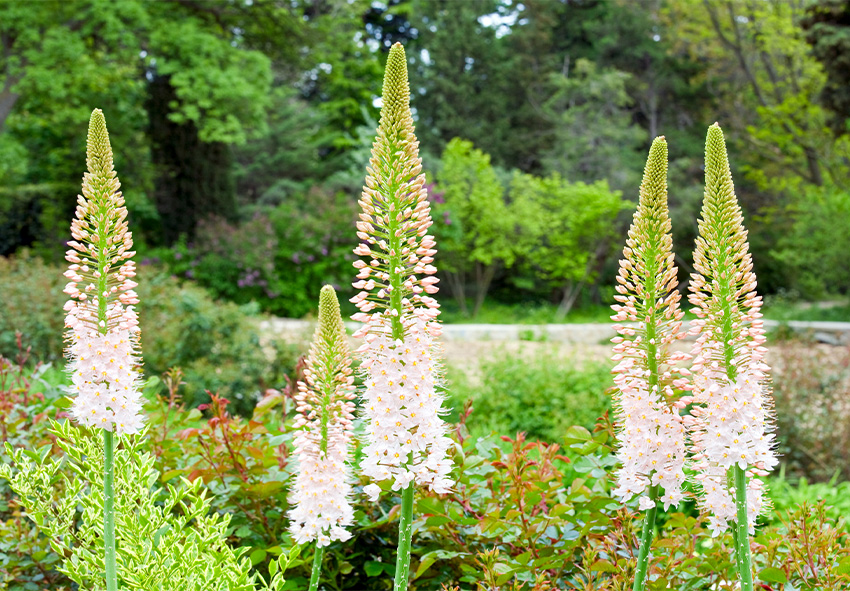
Eremurus, also known as Foxtail Lilies, are stunning plants with tall spikes of flowers that make a dramatic impact in any garden. However, sometimes they may not rebloom or produce fewer flowers in subsequent seasons. Several factors can contribute to this lack of blooming, including insufficient sunlight, nutrient deficiencies, or overcrowding.
To encourage Eremurus to bloom again, it’s important to ensure that they receive full sun, at least 6-8 hours of direct sunlight daily. Lack of sunlight can cause weak growth and fewer flowers. Additionally, proper watering and feeding practices are vital. Over-fertilizing with nitrogen can result in excessive foliage growth at the expense of flowering, so it’s important to use a balanced fertilizer.
Another key factor to promote reblooming is giving the plant a period of dormancy. Allow the foliage to die back naturally in the fall, and stop watering during this time to mimic the plant’s natural cycle. Lastly, dividing the plants every few years can help prevent overcrowding, which can inhibit blooming. With proper care and attention, Eremurus will continue to produce stunning blooms season after season.
Step-by-Step Guide to Ensuring Reblooming
To encourage reblooming in your Eremurus, start with proper deadheading and post-bloom care. Then, prepare the plant for dormancy, allowing the foliage to naturally die back. Dividing and transplanting every few years also helps to maintain vigor and promote strong, healthy growth for future blooms.
Step 1: Deadheading and Post-Bloom Care
After Eremurus flowers have faded, it’s important to remove the spent flowers to prevent the plant from putting energy into seed production. This process, known as deadheading, helps direct the plant’s resources back into the tuber for better growth and future blooms. Simply cut back the flower stalks, but leave the foliage intact.
The leaves are crucial because they gather energy through photosynthesis, which is stored in the tuber for the next season. Removing the flower stalks too early may reduce the plant’s ability to build up enough energy to support blooming the following year. Deadheading not only improves the plant’s appearance but also prevents the plant from wasting resources on seeds.
After cutting back the flower stems, continue caring for the plant as usual, allowing it to thrive. With this simple post-bloom care, your Eremurus will be better prepared for the next blooming season, ensuring a beautiful display of flowers year after year.
Step 2: Preparing Eremurus for Dormancy
To encourage Eremurus to rebloom the following year, it’s important to properly prepare the plant for dormancy. As the growing season comes to an end, allow the foliage to naturally yellow and die back before cutting it down. This process allows the plant to store energy in the tubers for future growth. Cutting the leaves too soon may deprive the plant of the energy it needs to thrive.
During the dormancy period, it’s important to reduce watering. Eremurus does not require much moisture during dormancy, and keeping the soil too wet can result in tuber rot. Allow the soil to dry out and avoid overwatering during the winter months. Additionally, ensure that the tubers are not exposed to freezing temperatures, as this can damage them.
By mimicking the plant’s natural life cycle and providing it with the proper rest period, you’ll help your Eremurus conserve energy, which will contribute to better blooming in the next growing season.
Step 3: Dividing and Transplanting Eremurus
Eremurus plants should be divided every 4-5 years to prevent overcrowding, which can hinder growth and reduce the plant’s ability to bloom. Over time, tubers multiply, and without enough space to spread, the plant’s growth becomes stunted, resulting in weaker flowers. Dividing the tubers ensures the plant stays healthy and vigorous, promoting stronger growth and better blooms.
To divide Eremurus, wait until the plant has gone dormant, typically in the late autumn or early winter, when the foliage has yellowed and died back. Carefully dig up the tubers, separating the healthy offsets from the main tuber. Ensure that each tuber has at least one growing bud. Replant the divisions immediately in nutrient-rich, well-draining soil.
After transplanting, water the newly divided tubers thoroughly and allow them to settle into their new spots. This will encourage fresh growth in the spring, leading to a renewed bloom cycle. Regular division helps maintain the plant’s vitality and ensures continuous, vibrant flowering.
Common Problems with Eremurus and How to Fix Them
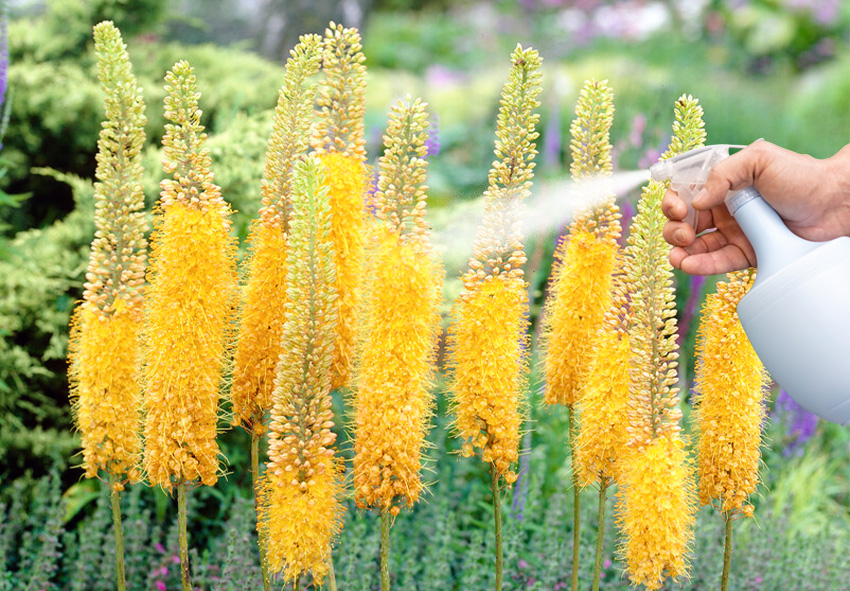
Eremurus, or Foxtail Lilies, are impressive plants with striking flower spikes that can add height and beauty to any garden. However, like all plants, they are not immune to common gardening challenges. Identifying and addressing these issues quickly can help ensure your Eremurus thrives and continues to bloom year after year. Whether it’s poor blooming, yellowing leaves, or weak stems, it’s essential to understand the causes behind these problems and the steps needed to fix them.
Eremurus are generally low-maintenance plants, but they can suffer from a few specific issues. Some of the most common problems include the plant’s failure to bloom, yellowing leaves, and bent or broken flower stems. These problems are often related to factors such as insufficient sunlight, improper watering, or lack of support. Fortunately, all of these issues can be easily addressed with some care and attention.
By providing the right growing conditions—such as full sun, well-draining soil, and proper watering—Eremurus will be better equipped to grow strong, healthy, and bloom beautifully. Additionally, implementing strategies such as proper support for tall flower spikes and the use of the right fertilizers can help prevent many of these common problems. In the following sections, we’ll take a closer look at these specific issues and provide detailed solutions to keep your Eremurus looking its best.
Troubleshooting Guide
Eremurus plants are relatively low-maintenance but can experience problems such as poor blooming, yellowing leaves, or bent stems. Identifying and resolving these issues early ensures your Eremurus will thrive. Below, we’ll cover the most common problems and offer step-by-step solutions to restore their health and vitality.
Issue 1: Eremurus Not Blooming
One of the most disappointing problems for gardeners is when their Eremurus fails to bloom. The lack of flowers can be due to insufficient sunlight or poor soil conditions. Understanding why this happens and how to address it is crucial for ensuring a healthy and blooming plant.
- Cause: Insufficient sunlight or poor soil drainage is the most common reason Eremurus fails to bloom. Without the proper exposure to sunlight, Eremurus plants struggle to flower. Similarly, if the soil doesn’t drain well, the tubers may not thrive.
- Solution: To encourage blooming, make sure your Eremurus gets at least 6-8 hours of full sunlight per day. If the plant is in a shaded area, consider relocating it to a sunnier spot. Additionally, improve soil drainage by adding organic matter or planting in well-drained soil. These steps will help ensure a strong flowering cycle and promote long-lasting blooms.
Issue 2: Yellowing Leaves or Weak Growth
Yellowing leaves or weak growth in Eremurus plants are often signs of stress, typically caused by overwatering or nutrient deficiencies. Identifying and treating these issues early will help revive your plants and promote healthy growth.
- Cause: Overwatering can lead to root rot, which results in yellowing leaves and stunted growth. Additionally, a lack of essential nutrients, especially phosphorus, can weaken your plant and reduce its ability to flower.
- Solution: To prevent overwatering, ensure your Eremurus is planted in well-draining soil. Water the plant thoroughly but allow the soil to dry out between waterings. If the issue is a nutrient deficiency, particularly phosphorus, apply a balanced fertilizer with a higher phosphorus ratio (like 10-20-10) in early spring. This will support root growth and help your plant produce stronger, healthier blooms. Additionally, avoid nitrogen-heavy fertilizers, as they can promote excessive leaf growth at the expense of flowers.
Issue 3: Eremurus Stems Falling Over
Eremurus flowers are tall and elegant but can be vulnerable to falling over, especially in windy conditions or when they lack proper support. This issue can be frustrating as it may result in broken stems or flattened blooms.
- Cause: Tall Eremurus stems are prone to bending or toppling over in strong winds or if they are not adequately supported during the flowering process. The tall flower spikes can become heavy, especially when in full bloom.
- Solution: To prevent the stems from falling over, use sturdy supports such as stakes, trellises, or plant cages to hold the flower spikes upright. Place the supports in the ground before the plants grow too tall, and gently tie the stems to them. Planting Eremurus in clusters can also provide natural support, as the plants will help hold each other up. Additionally, if your garden is exposed to strong winds, consider planting Eremurus near other taller plants or structures that can act as a windbreak, offering further protection to the stems.
Propagating Eremurus: Growing More Beautiful Blooms
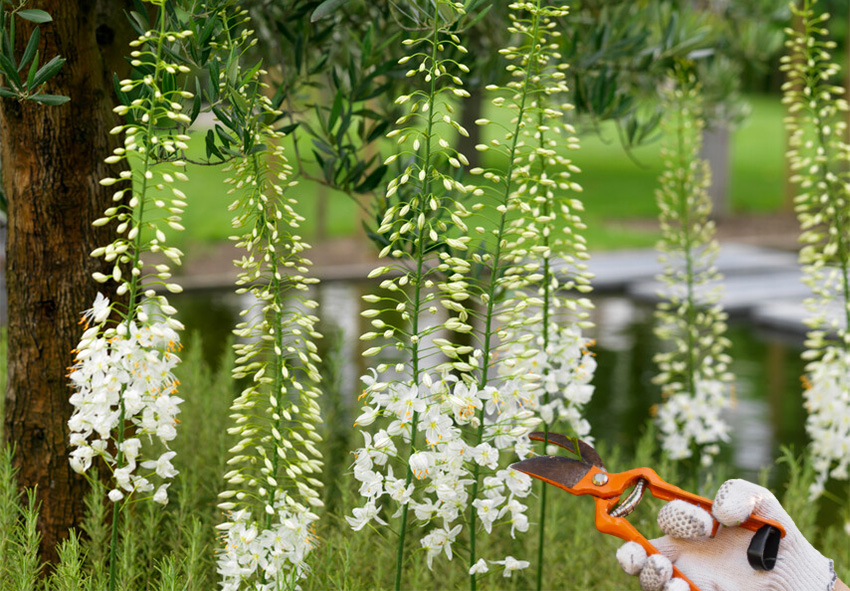
Eremurus, or Foxtail Lilies, can be propagated in two primary ways: by dividing their tubers or from seeds. Both methods can help you grow more of these stunning, tall flowers, but the key to successful propagation lies in choosing the right technique for your needs and patience level. Dividing tubers is the most efficient method for quickly multiplying Eremurus, especially if you want to maintain the same characteristics of the parent plant. However, growing from seeds is a more lengthy process, taking several years to produce blooms, but it can result in interesting new hybrids. Understanding the best practices for both methods ensures healthy propagation and abundant flowers.
Eremurus propagation is best done at specific times in the growing cycle. Dividing tubers can be done once the plant begins to go dormant at the end of summer, while sowing seeds is typically done in late winter or early spring. Both methods require attention to detail, such as proper soil preparation, ensuring adequate light, and providing the right moisture levels. With care, propagating Eremurus can lead to more vibrant and abundant blooms in your garden, allowing you to share these stunning plants with others or fill your own garden with beautiful Foxtail Lilies.
How to Propagate Eremurus Step-by-Step
To propagate Eremurus, you can divide tubers or grow from seeds. Dividing tubers ensures quicker, more reliable results, while seed propagation takes several years for flowering. Both methods require proper care and attention, ensuring healthy growth for beautiful blooms in your garden.
Step 1: Dividing Eremurus Tubers (The Best Method)
The most effective way to propagate Eremurus is by dividing the tubers, a process that allows you to create new plants while maintaining the original plant’s characteristics. Begin by digging up the tubers in late summer or early fall after the plant has gone dormant. Use a garden fork or spade to carefully lift the tubers from the soil, being cautious not to damage them. Once unearthed, gently separate the healthy offsets from the main tuber. Each offset should have its own set of roots and should be at least a few inches in size.
After separating, plant the new tubers in well-draining soil with adequate space between them, around 12-18 inches apart. Water thoroughly after planting but avoid overwatering, as excess moisture can cause the tubers to rot. The newly divided tubers will develop into full-grown plants by the following season, producing flowers that resemble the parent plant. Dividing tubers every few years will help rejuvenate the plant and prevent overcrowding.
Step 2: Growing Eremurus from Seeds
Growing Eremurus from seeds is a more time-consuming process, but it can result in interesting variations and hybrids. Start by collecting the seeds once the flowers have bloomed and dried. Sow the seeds in cool conditions, ideally in late winter or early spring, to simulate the natural conditions for germination. Plant the seeds in a shallow tray or pot filled with well-draining soil. Keep the soil consistently moist, but avoid waterlogging.
Place the seeds in a location with indirect light, as direct sunlight may be too harsh for young seedlings. The seeds typically take several weeks to germinate, and once they’ve sprouted, they can be transplanted into larger pots or directly into the garden. Expect to wait 2-4 years before the seedlings flower, as Eremurus grown from seed requires time to mature. Though this method takes longer, it can result in unique plants that offer a different aesthetic compared to their parent plants, making it a rewarding project for patient gardeners.
Frequently Asked Questions (FAQs) about Eremurus
1. When is the best time to plant Eremurus tubers?
The best time to plant Eremurus tubers is in the fall, typically from September to November, before the ground freezes. Planting in autumn allows the roots to establish before winter, ensuring strong growth and blooms in late spring to early summer. Make sure the soil is well-draining and the planting site receives full sun for optimal flowering performance.
2. Can I order Holland Eremurus from your online store?
Yes, you can order top-quality Holland-grown Eremurus (also known as Foxtail Lilies) from our online store Dutch-bulbs.com. These striking, tall spires make a dramatic statement in any garden and are shipped as premium bare-root tubers, ready for planting. We source our Eremurus directly from trusted Dutch growers to ensure healthy, vigorous blooms.
3. Can Eremurus be grown in containers?
While Eremurus is best suited to garden beds due to its deep roots and tall growth, it can be grown in large, deep containers. Use a pot with excellent drainage and at least 18 inches deep. A sandy, well-draining soil mix is essential. Keep the container in full sun, and protect the plant from harsh winds since tall flower spikes may need support.
4. Do Eremurus need winter protection?
Eremurus are relatively hardy but can benefit from winter protection in colder climates. In areas with harsh winters or poor drainage, mulching with straw or leaves helps insulate the crown. If your soil is heavy clay or prone to waterlogging, consider lifting and storing tubers in a dry, frost-free place until spring. Ensuring good drainage is the most important factor for winter survival.
5. Why isn’t my Eremurus blooming?
If your Eremurus isn’t blooming, it may be due to a few common issues: insufficient sunlight, poor drainage, overcrowding, or planting too deep. Eremurus requires full sun and well-draining soil to thrive. Avoid soggy or compacted soils, which can cause root rot. Also, be patient—Eremurus can take a season or two to establish before blooming fully, especially if grown from younger tubers.
Published: 21.04.2025
